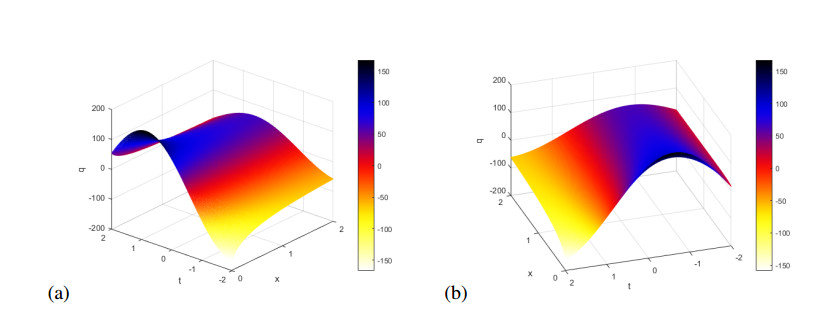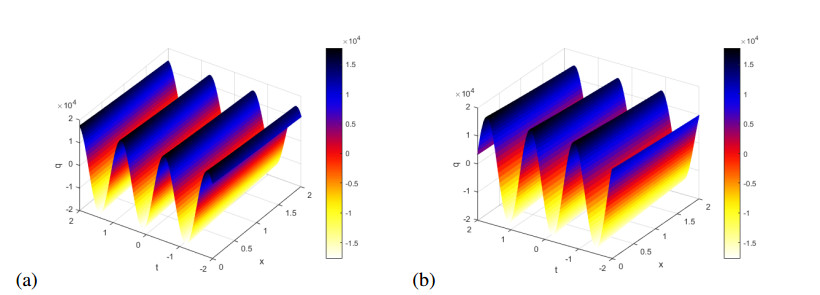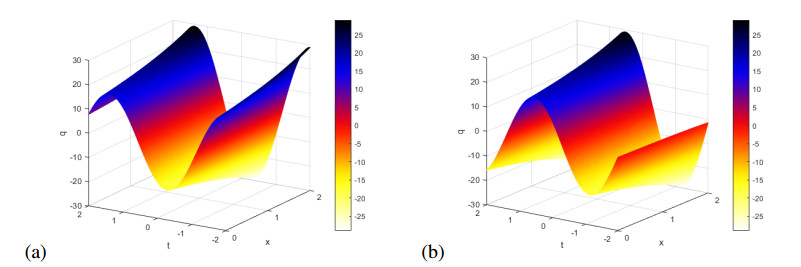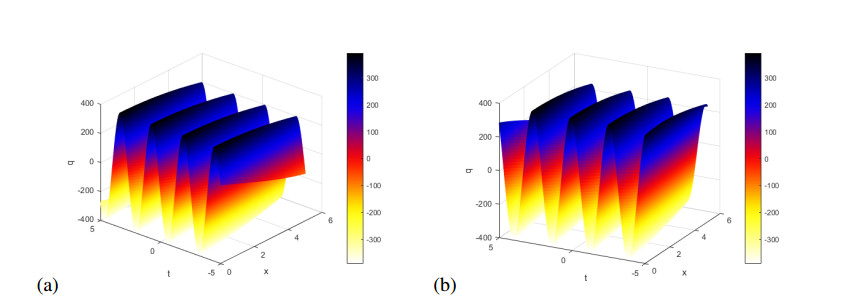In this work, three mathematical methods are applied, namely, the exp(-φ(ξ))-expansion method, the sine-cosine technique and the Riccati-Bernoulli sub-ODE method for constructing many new exact solutions of the unstable nonlinear Schrödinger equation. The exact solutions are obtained in the form of rational, exponential, trigonometric, hyperbolic functions. These solutions may be so important significance for the explanation of some practical physical problems. The computational work and obtained results show that the presented methods are simple, efficient, straightforward and powerful. Moreover, the presented methods can be employed to many other types of nonlinear partial differential equations arising in mathematics, mathematical physics and other areas of natural sciences. Some solutions are simulated for some particular choices of parameters.
1.
Introduction
In recent years, nonlinear partial differential equations (NPDEs) are widely used to describe complex phenomena in various fields of sciences, such as fluid mechanics, plasma, chemical reactions, optical fibers, solid state physics, relativity, ecology, gas dynamics physics and optical fiber, [1,2,3,4,5,6,7,8,9,10,11]. Therefore, exploring exact solutions for NPDEs plays an important role in nonlinear science. These solutions might be essential and important for the exploring some physical phenomena. Therefore investigating new technique to solve so many problems is so interesting topic. Thus, many new methods have been introduced, such as the F-expansion method [12,13], (G′G)− expansion method [14,15], tanh-sech method [16,17,18], exp-expansion method [19,20], the homogeneous balance method [21,22], Jacobi elliptic function method [23,24], sine-cosine method [25,26,27], extended tanh-method [28,29] and the Riccati-Bernoulli sub-ODE method [30,31,32,33] proposed for solving more complicated problems. Indeed, there are recent development in analytical methods for investigation solutions for NPDEs, see [34,35,36,37,38,39,40].
The nonlinear Schrödinger equations (NLSEs) are so important models in nonlinear evolution equations, which come in many areas of applied sciences such as nonlinear optics, quantum mechanics, fluid dynamics, molecular biology, elastic media, hydrodynamics, biology and plasma physics.
This paper is concerned with the unstable nonlinear Schrödinger equation (UNS) [41,42] given by
where, η,γ is a free parameter and q=q(x,t) is a complex-valued function. Equation (1.1) is a type of nonlinear Schrödinger equation with space and time exchanged. This equation prescribes a time evolution of disturbances in unstable media. The behavior of type occurs for the two-layer baroclinic instability and the lossless symmetric two-stream plasma instability [43]. To the best of our knowledge, no previous research work has been done using the proposed methods for solving the unstable nonlinear Schrödinger equation. Actually, many numerical and analytical methods have been also implemented to get solutions for Eq (1.1) such as modified Kudraysov method, the sine-Gordon expansion approach [41], expa method and hyperbolic function method [42], the new Jacobi elliptic function rational expansion method and the exponential rational function method [44], the extended simple equation method[45].
The main aim of this paper is to explore the UNS equation using exp(−φ(ξ))-expansion method, sine-cosine method and Riccati-Bernoulli sub-ODE method. We also show that the Riccati-Bernoulli sub-ODE technique gives infinite solutions. Actually, we introduce new types of exact analytical solutions. Comparing our results with other results, one can see that our results are new and most extensive. Indeed the new solutions presented in this article are so important in the theory of soliton. Moreover these solutions turn out to be very useful for Physicists to explain many interesting physical phenomena.
The rest of the paper is arranged as follows: In Section 2, the exp-function method, sine-cosine method and Riccati-Bernoulli sub-ODE method are briefly reviewed. In Section 3, some new exact solutions of the unstable Schrödinger equation are presented. Discussion of our results and comparing with the results of other authors is in Section 4. Conclusion and future works will appear in Section 5.
2.
Description of methodologies
We present a brief description about the exp(−φ(ξ))-expansion method, sine-cosine method and Riccati-Bernoulli sub-ODE method to obtain new exact solutions for a given NPDE. For this goal, consider a NPDE in two independent variables x and t as
where G is a polynomial in ϑ(x,t) and its partial derivatives. The main steps are as follows [30]:
Step 1. Introducing the transformation
varies Eq (2.1) to the following ordinary differential equation (ODE):
where D is a polynomial in ϑ(ξ) and its derivatives such that the superscripts denote the ordinary derivatives with respect to ξ.
2.1. The exp(−φ(ξ))-expansion method
According to the exp(−φ(ξ))-expansion technique [19,20,31], we assume that the solution of Eq (2.3) can be written in a polynomial form of exp(−φ(ξ)) as follows
where φ(ξ) obeys the following ODE
Eq (2.5) has the following solutions:
1. At λ2−4ν>0,ν≠0,
2. At λ2−4ν<0,ν≠0,
3. At λ2−4ν>0,ν=0,λ≠0
4. At λ2−4ν=0,ν≠0,λ≠0,
5. At λ2−4ν=0,ν=0,λ=0,
Here C is an arbitrary constant.
Finally, superseding Eq (2.4) with Eq (2.5) into Eq (2.3) and agammaegating all terms of the same power exp(−mφ(ξ)), m=0,1,2,3,.... After that equating them to zero, we get algebraic equations solved by Mathematica or Maple to obtain the values of ai. Hence, we get the solutions (2.4), which give the exact solutions of Eq (2.3).
2.2. The sine-cosine technique
The solutions of Eq (2.3) can be expressed in the form [46,47]
or in the form
where α,β and r≠0, are parameters determined in sequel. From (2.11) we have
and from (2.12) we have
Finally, superseding Eq (2.13) or Eq (2.14) into Eq (2.3), then balance the terms of the cosine functions (2.14) or the sine functions (2.13). Then, we sum all terms with the same power in cosr(βξ) or sinr(βξ) and equating their coefficients to zero in order to obtain an algebraic equations in the unknowns β,α and r. Solving this system yields these unknown constants.
2.3. Riccati-Bernoulli sub-ODE method
According to description of this method [30,31,32,33,48,49], we assume that Eq (2.3) has the following solution:
where a,b,c and n are constants calculated later. From Eq (2.15), we get
The exact solutions of Eq (2.15), for an arbitrary constant μ are given as follow:
1. For n=1, the solution is
2. For n≠1, b=0 and c=0, the solution is
3. For n≠1, b≠0 and c=0, the solution is
4. For n≠1, a≠0 and b2−4ac<0, the solution is
and
5. For n≠1, a≠0 and b2−4ac>0, the solution is
and
6. For n≠1, a≠0 and b2−4ac=0, the solution is
Bäcklund transformation
When ϑm−1(ξ) and ϑm(ξ)(ϑm(ξ)=ϑm(ϑm−1(ξ))) are the solutions of Eq (2.15), we obtain
namely
Integrating Eq (2.26) once with respect to ξ, we obtain the following Bäcklund transformation of Eq (2.15):
where K1 and K2 are arbitrary constants. If we get a solution for this equation, we use Eq (2.27) to obtain infinite sequence of solutions of Eq (2.15), as well of Eq (2.1).
3.
Application
In order to solve the Eq (1.1), using exp(−φ(ξ))-expansion method and the Riccati-Bernoulli sub-ODE method, the following solution structure is selected
where p, ν, k and ω are constants. Substituting (3.1) into (1.1), we have the ODE
Now we apply exp(−φ(ξ))-expansion and the Riccati-Bernoulli sub-ODE methods for Eq (3.2).
3.1. Solving Eq (1.1) using the exp(−φ(ξ))-expansion method
According to the exp(−φ(ξ))-expansion technique, Eq (3.2) has the following solution
where A0 and A1 are constants and A1≠0. It is easy to see that
Superseding u, u″, u3 into Eq (3.2) and hence equating the coefficients of exp(−φ) to zero, we obtain
Solving Eqs (3.6)–(3.9), we get
We consider only one case, whenever the other cases follow similarly. In this case, the solution of Eq (3.3) reads as:
Superseding Eqs (2.6)–(2.7) into Eq (3.10), we obtain:
Case 1. At λ2−4μ>0,μ≠0,
Using Eqs (3.1) and (3.11) the solutions of equation (1.1) are
Case 2. At λ2−4μ<0,μ≠0,
Using Eqs (3.1) and (3.13) the solutions of Eq (1.1) are
Case 3. At λ2−4μ>0,μ=0,λ≠0
Using Eqs (3.1) and (3.15) the solutions of Eq (1.1) are
Case 4. At λ2−4μ=0,μ≠0,λ≠0,
Using Eq (3.1) and (3.17) the solutions of Eq (1.1) are
Case 5. At λ2−4μ=0,μ=0,λ=0,
Using Eqs (3.1) and (3.19) the solutions of Eq (1.1) are
Here k,λ,μ,C are constants, ξ=k(x−2pt) and χ=px−12(4γ+k2(λ2−4μ)+2p2)t.
We have plotted these solutions in Figures 1–5. Figure 1(a) shows the real part of q=q1(x,t) in (3.12), while Figure 1(b) shows imaginary part of this solution for k = 1.5, p = 1.5, γ = 1.3, λ = 2.3, μ=1, ω = -4.5, ν = -6.3012 and C = 1.4.
Figure 2(a) shows the real part of q=q3(x,t) in (3.14), while Figure 2(b) shows imaginary part of this solution for k = 1.2, p = 1.2, γ = 1.8, λ = 1.2, μ=2, ω = -2.88, ν = -0.3168 and C = 0.4.
Figure 3(a) shows the real part of q=q5(x,t) in (3.16), while Figure 3(b) shows imaginary part of this solution for k = 0.4, p = 0.6, γ = 0.3, λ = 1.2, μ=0, ω = -0.48, ν = -1.0752 and C = 1.
Figure 4(a) shows the real part of q=q7(x,t) in (3.18), while Figure 4(b) shows imaginary part of this solution for k = 0.5, p = 0.5, γ = 2.3, λ = 2, μ=1, ω = -0.5, ν = -4.85 and C = 4.
Figure 5(a) shows the real part of q=q9(x,t) in (3.20), while Figure 5(b) shows imaginary part of this solution k = -0.7, p = -0.5, γ = 0.8, λ=μ = 0, ω = -0.7, ν = -1.85 and C = 4.
3.2. Solving Eq (1.1) using the sine-cosine method
According to sine-cosine technique, subtitling Eq (2.13) into Eq (3.2), gives
Thus by comparing the coefficients of the sine functions, we get
Solving this system gives
for p2+ν+2γ<0 and k≠0. We get the same result if we also use the cosine method (2.14). Thus, the periodic solutions are
and
Using Eqs (3.1) and (3.19) the solutions of Eq (1.1) are
and
However, for p2+ν+2γ>0 and k≠0. we obtain the soliton and complex solutions
and
Using Eqs (3.1) and (3.19) the solutions of equation
and
Figure 6(a) shows the real part of q=˜q1(x,t) in (3.26), while Figure 6(b) shows imaginary part of this solution for p = 2, ν = -2, γ = -3, k = 2 and ω = 1.
Figure 7(a) shows the real part of q=˜q5(x,t) in (3.30), while Figure 7(b) shows imaginary part of this solution for p = 2.6, ν = 2.1, γ = 3.1, k = 1.2 and ω = 2.
3.3. Solving Eq (1.1) using the Riccati-Bernoulli Sub-ODE method
According to Riccati-Bernoulli Sub-ODE technique, substituting Eq (2.16) into Eq (3.2), we get
Putting n=0, Eq (3.32) becomes
Putting each coefficient of ui(i=0,1,2,3) to zero, we get
Solving Eqs (3.34)–(3.37), we have
Hence, we give the cases of solutions for Eq (3.2) as follows
Rational function solutions: (When b=0 and c=0, i.e., p2+ν+2γ=0)
The solution of Eq (3.2) is
Therefore, using Eqs (3.1) and (3.42), the following new explicit exact solution of the unstable nonlinear Schrödinger equation can be acquired
where p,ν,γ,k,ω,μ are arbitrary constants.
Trigonometric function solution: (When p2+ν+2γ>0)
Superseding Eq (3.1) and Eqs (3.38)–(3.41) into Eqs (2.21) and (2.22), then the exact solutions of Eq (1.1) are
and
Consequently, using Eqs (3.1) and (3.42), the following new explicit exact solution for the unstable nonlinear Schrödinger equation can be obtained
and
where p,ν,γ,k,ω,μ are arbitrary constants.
Hyperbolic function solution : (When p2+ν+2γ<0)
Substituting Eq (3.1) and Eqs (3.38)–(3.41) into Eqs (2.23) and (2.24), then the exact solutions of Eq (1.1) are
and
Subsequently, the following new explicit exact solution to the unstable nonlinear Schrödinger equation can be gained
and
where p,ν,γ,k,ω,μ are arbitrary constants.
We have plotted these solutions in Figures 8–10. Figure 8(a) shows the real part of q=ˆq2(x,t) in (3.46), while Figure 8(b) shows imaginary part of this solution for k = 0.5, p = -1.3, ω = 1.3, ν = 1.4, γ = 1.5 and μ = 1.
Figure 9(a) shows the real part of q=ˆq6(x,t) in (3.50), while Figure 9(b) shows imaginary part of this solution for k = 1.5, p = 1.3, ω = -3.9, ν = -2.4, γ = -1.3 and μ = 1.
Figure 10(a) shows the real part of q=ˆq1(x,t) in (3.43), while Figure 10(b) shows imaginary part of this solution for k = 0.2, a = 5, p = 1.2, ω = -0.48, ν = 1.4 and μ = 1.
Remark 1. Using Eq (2.27) for ui(x,y), i = 1, ..., 9, once, then Eq (3.2) as well as for Eq (1.1) has an infinite solutions. In sequence, by applying this process again, we get new families of solutions.
where B3,p,ν,γ,k,ω and μ are arbitrary constants.
4.
Results and discussions
In this article, the exp(−φ(ξ))-expansion, the sine-cosine and Riccati-Bernoulli sub-ODE techniques have been efficiently applied to construct many new solutions. As an outcome, a number of new exact solutions for the UNS equation were formally derived. Namely, the exp(−φ(ξ))-expansion method gives a first family of ten solutions. Whereas, sine-cosine method give another different second family of eight solutions. Indeed, Riccati-Bernoulli sub-ODE method gives a wide range of new explicit exact solutions including rational functions, trigonometric functions, hyperbolic functions and exponential functions in a straightforward manner. The effectiveness and helpfulness of the exp(−φ(ξ))-expansion, the sine-cosine and Riccati-Bernoulli sub-ODE methods to deal with UNS equation was proved. As a success, a wide range of new explicit exact solutions were obtained in a straightforward manner. Our study shows that the proposed three methods are reliable in handling NPDEs to establish a variety of exact solutions. Finally, we have plotted some 3D graphs of these solutions and we have shown that these graphs can be controlled by adjusting the parameters.
Remark 2.
1. Comparing our results concerning the UNS equation with the results in [41,42,44,45], one can see that our results are new and most extensive. Indeed, choosing suitable values for the parameters similar solutions can be verified.
2. The Riccati-Bernoulli sub-ODE method has an interesting feature, that admits infinite solutions, which has never given for any other method.
3. The three proposed methods in this article are efficient, powerful and adequate for solving other types of NPDEs and can be easily extended to solve nonlinear fractional differential equations, see [32,33,49,50,51,52,53,54,55,56].
5.
Conclusions and future works
The exp(−φ(ξ))-expansion, sine-cosine and Riccati-Bernoulli sub-ODE techniques have successfully been applied for the UNS equation. Many new exact solutions are obtained during the analytical treatment. The availability of computer systems like Matlab or Mathematica facilitates avoids us the tedious algebraic calculations. Indeed, the obtained solutions are of significant importance in the studies of applied science as they help in explaining some interesting physical mechanism for the complex phenomena. The 3D graphs of some exact solutions are plotted for suitable parameters. Finally, the proposed methods can be applied for a wide range of nonlinear partial differential equations arising in natural sciences. Currently, work is in progress on the applications of the proposed methods in this paper in order to solve the other nonlinear partial differential equations. Indeed these methods can be extended to solve fractional partial differential equations.
Acknowledgments
The authors thank the editor and anonymous reviewers for their valuable comments and suggestions.
Conflict of interest
The authors declare no conflict of interest.
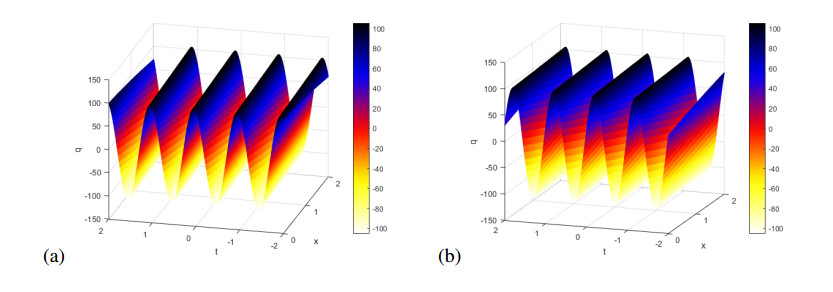









 DownLoad:
DownLoad:

